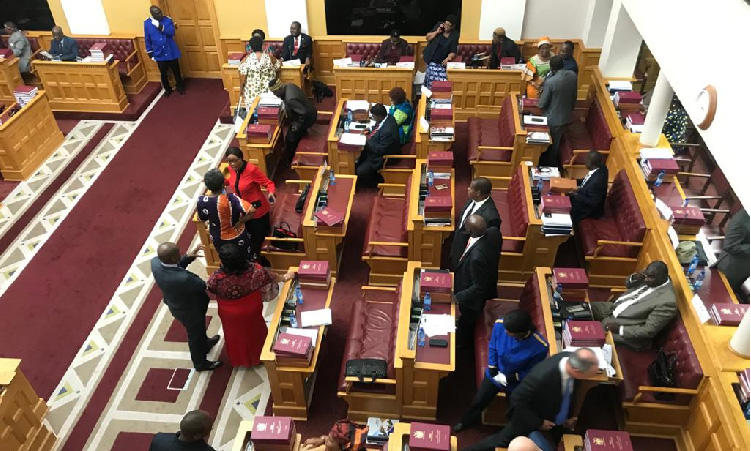NAMIBIA is probably not unique in having a plethora of plans and projects and policies on a variety of important national issues.
Most of these are wordy documents, not necessarily even accessible to the broader public, and so there is a burning need for us to simplify our goals and objectives in a language that everyone understands and with a brevity that makes them understandable. Our broad national policy guidelines towards a prosperous future for all are encapsulated, for example, in a weighty document known as Vision 2030.Many politicians, social commentators and others often refer to this in their speeches and statements, and it always begs the question as to how many Namibians know exactly what Vision 2030 stands for.Many simply reference the document without perhaps ever having read it.Whether we achieve these aims and goals by that date is academic given that most don’t know what we are supposed to be working towards.Would it not make much greater sense for someone to succinctly summarise this inaccessible tome into a simplified 10-point plan, or something along those lines, which could easily be made known to the broader public? If we want to take our people along with us and share the vision of 2030, then we should ensure, as a matter of urgency, that we make it simple and clear.But this is not the only example.An SMS writer recently took the example of ETSIP, and urged to simplify it down to what it really stands for, namely, quality education.This reader hit the nail on the head.We doubt that even all the wider educational fraternity is aware of the contents of the ETSIP programme.Recently the Minister of Health announced a workshop with a view to formulating a strategic five-year plan for this sector.Necessary it might be to do this, but there is more of a need to make this ‘strategic plan’, when it finally emerges, as accessible to the people as possible, so that they understand and know what the health sector is working towards.What meaning can it possibly have, after money is spent on lengthy workshops and the drafting of detailed policies, if few in the health sector itself, let alone the broader public, have insight into this document? Minister Richard Kamwi did make some good points when he announced the workshop, and he did say that the plan should be a guiding document for all management decisions and actions, and should also be dynamic and realistic.However, he did not add that it should be, most importantly, short and brief and accessible, so that the health sector know their priorities, and the public know what to expect of them.Kamwi said at the launch that “we all know that the ultimate goal is Vision 2030.Our five strategic plans should therefore be aligned and responsive to NDP III in order to enhance synergy for attaining greater results”.And unfortunately, this statement would be incomprehensible gobbledygook for a majority of our population, who are not familiar with either the detail in Vision 2030 or NDP III for that matter! So it brings them no closer to understanding our health priorities and plans.Again, unfortunately, many public officials themselves resort to praising the ETSIPs and NDP IIs and IIIs and Vision 2030s without wondering whether their audience, and those they serve, namely the public, understand much at all of what they are saying! We would seriously propose that important documents such as these, and additional ones that have not been mentioned, should be summarised down to a few pertinent points and action plans that everybody can understand, and not only comprehend, but also then assist in working towards.It stands to reason that if the broader Namibian public don’t know what Vision 2030 is, then how can they assist in working towards its attainment? Public officials must try, not only to speak in language that everyone understands, but also to promote public understanding of the important policies and plans that underwrite the various sectors of our country.It is vitally important to get national buy-in if we hope to go forward in all our major sectors, and we cannot achieve a national energy towards a goal if there is scant understanding of what it all means.Our broad national policy guidelines towards a prosperous future for all are encapsulated, for example, in a weighty document known as Vision 2030.Many politicians, social commentators and others often refer to this in their speeches and statements, and it always begs the question as to how many Namibians know exactly what Vision 2030 stands for.Many simply reference the document without perhaps ever having read it.Whether we achieve these aims and goals by that date is academic given that most don’t know what we are supposed to be working towards.Would it not make much greater sense for someone to succinctly summarise this inaccessible tome into a simplified 10-point plan, or something along those lines, which could easily be made known to the broader public? If we want to take our people along with us and share the vision of 2030, then we should ensure, as a matter of urgency, that we make it simple and clear.But this is not the only example.An SMS writer recently took the example of ETSIP, and urged to simplify it down to what it really stands for, namely, quality education.This reader hit the nail on the head.We doubt that even all the wider educational fraternity is aware of the contents of the ETSIP programme.Recently the Minister of Health announced a workshop with a view to formulating a strategic five-year plan for this sector.Necessary it might be to do this, but there is more of a need to make this ‘strategic plan’, when it finally emerges, as accessible to the people as possible, so that they understand and know what the health sector is working towards.What meaning can it possibly have, after money is spent on lengthy workshops and the drafting of detailed policies, if few in the health sector itself, let alone the broader public, have insight into this document? Minister Richard Kamwi did make some good points when he announced the workshop, and he did say that the plan should be a guiding document for all management decisions and actions, and should also be dynamic and realistic.However, he did not add that it should be, most importantly, short and brief and accessible, so that the health sector know their priorities, and the public know what to expect of them.Kamwi said at the launch that “we all know that the ultimate goal is Vision 2030.Our five strategic plans should therefore be aligned and responsive to NDP III in order to enhance synergy for attaining greater results”.And unfortunately, this statement would be incomprehensible gobbledygook for a majority of our population, who are not familiar with either the detail in Vision 2030 or NDP III for that matter! So it brings them no closer to understanding our health priorities and plans.Again, unfortunately, many public officials themselves resort to praising the ETSIPs and NDP IIs and IIIs and Vision 2030s without wondering whether their audience, and those they serve, namely the public, understand much at all of what they are saying! We would seriously propose that important documents such as these, and additional ones that have not been mentioned, should be summarised down to a few pertinent points and action plans that everybody can understand, and not only comprehend, but also then assist in working towards.It stands to reason that if the broader Namibian public don’t know what Vision 2030 is, then how can they assist in working towards its attainment? Public officials must try, not only to speak in language that everyone understands, but also to promote public understanding of the important policies and plans that underwrite the various sectors of our country.It is vitally important to get national buy-in if we hope to go forward in all our major sectors, and we cannot achieve a national energy towards a goal if there is scant understanding of what it all means.
Stay informed with The Namibian – your source for credible journalism. Get in-depth reporting and opinions for
only N$85 a month. Invest in journalism, invest in democracy –
Subscribe Now!









